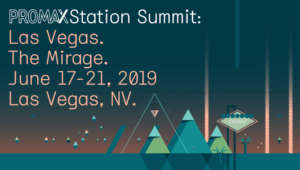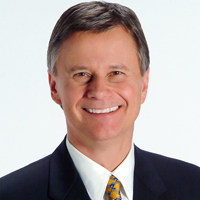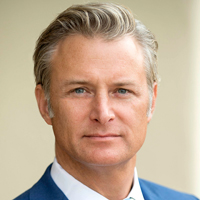
Promax Summit Targets Station Concerns, Needs

 These are busy days at Promax. While recovering from its big annual conference in Los Angeles, the TV marketing and promotion trade group is prepping for its annual TV Station Summit that opens a four-day run (June 17-21) in Las Vegas next week.
These are busy days at Promax. While recovering from its big annual conference in Los Angeles, the TV marketing and promotion trade group is prepping for its annual TV Station Summit that opens a four-day run (June 17-21) in Las Vegas next week.
Unlike the Los Angeles conference, which attracts executives from across the TV spectrum, the ninth Station Summit focuses sharply on the marketing and promotional needs of stations and station groups.
And from its beginning in 2011, the summit has also served as a gathering spot where the broadcast networks and Hollywood syndicators can share and coordinate plans for the fall TV season with the stations that air their programs.
In this interview with TVNewsCheck Editor Harry A. Jessell, Promax CEO Steve Kazanjian and Station Summit VP Rick Swanson talk about this year’s summit with its emphasis on growing the broadcast audience, training and recruitment.
An edited transcript:
How many people are coming to Vegas for the summit?

Rick Swanson
Swanson: We hope that there will be somewhere around 1,200.
So, this conference continues to draw well after 10 years. That’s saying something given all the consolidation.
Swanson: We are actually up a tick year over year. I think we have established real pulling power for the summit and the idea that the ownership groups would come and attend and hold their corporate meetings is now well established.
It has become a pattern and something people count on. The only thing that prevents people from coming is obviously the corporate ability to pay the T&E. It is not for lack of interest.
And the T&E is a bit of a moving target. In even years, where everybody is flush with cash because of the Olympics and political, we always did well. But even that is flattening out a little bit as the economy is getting stronger. People are making budget again. It is not as cyclical as it was. And our awards entries are up as well.
So, that is another positive metric for you.
Swanson: Yeah, that speaks to the brand. The pulling power of the brand is very strong.
Kazanjian: One of the things that we have done with station summit — and Rick and I have been really focused on this over the last four years — is to develop multiple levels of value and, by doing that, you can create a really healthy community that has a good deal of stickiness because everyone who is there has a reason to be.
So, if you kind of break it down, the reason why you are seeing it grow year after over year is because it has become integral. It is not a “nice to have,” it is a “need to have” or a “need to attend.” We are really excited to see how that has transformed. It has become incredibly strong.
When this thing started, the networks and the syndicators were subsidizing some of that T&E. Is that still the case? Do they still do that?
Swanson: All our partners support the summit through partnership fees. Some partners take this a step further with direct support for their client stations in various forms.
The financial structure of station summit is a three-legged stool. It is first and foremost the contribution of our partners and that would include program distributors and the broadcast networks.
Then we have sponsors, the vendors and creative services suppliers to the industry. They pay a fee to display. And then of course the registration of the numbers is the third leg. Because those first two legs of the stool are so strong, it allows us to keep the registration for an individual member very low. This year we had an early registration of $400, which is a bargain.
Judging from the website, you have got all the networks and all the major syndicators. That wasn’t always the case, was it?

Steve Kazanjian
Kazanjian: Well so there is always a little ebb and flow. For example, we have made a significant outreach to Spanish-language broadcasters, Telemundo and Univision, and Telemundo has partnered with us. They have been an official partner with us in past years.
This year, they are attending, but they are not a partner and Univision has attended before. They have yet to become a partner.
Entertainment Studios, for example, has come in as a partner when they feel it makes sense for them. So, there is always a bit of ebb and flow, but the primary stakeholders are all in. And they are in enthusiastically, I might add. We probably had the fastest partnership agreement process this year ever. People stepped up.
Well, I guess Twentieth Television won’t be back this year.
Kazanjian: Right. Twentieth no longer exists as an entity. It’s part of the Walt Disney Co.
Swanson: And Disney is among our partners. In fact, they are bringing Tamron Hall. She is going to keynote with [Executive Producer] Bill Geddie on Wednesday morning, thanks to Disney.
Rick, you told our reporter, Paul Greeley, that you get 40% new people every year. Why so much churn?
Swanson: The stat is actually 20% to 40%. It’s because there is a lot of churn within the industry. There are always new people coming into creative services. Maybe somebody who produced commercials for sales now suddenly finds themselves as the marketing director for the whole station. Or, maybe somebody got tired of the news grind and wanted more creative opportunities so they moved over to creative services.
Kazanjian: Sometimes there is a gatekeeper who is determining who from a group is actually going to the summit. Let’s say they have 40 people on their team and they only budget for 15. They cycle through those people over the course of a few years.
Who are the station groups that will be holding private group meeting at the conference?
Swanson: So, all of the major station groups are at that big station summit, every single last one of them and a large number of them are holding corporate meetings. I can’t quite do it off the top of my head accurately, but I can get you the list. [Editor’s note: Promax later supplied the list, which included Tegna, Gray, Sinclair, Meredith, Tribune, News-Press & Gazette, Scripps, ABC, NBC, CBS and Fox.]
What should people expect from the agenda this year?
Swanson: With our [industry advisory] committee in mind, we identified two key themes for Summit 2019. The first theme is audience development. Now this is a trend that we have noticed bubbling up the past couple of years as stations are feeling more bullish about their core business than they did a handful of years ago. The economy is strong and there is research that indicates there is still value in the 30-second spot for the mattress store down the street who buys spots on the 5 o’clock news.
The other theme is planning. And this is a trend that we talked about when you mentioned the churn. We have a whole track of content dedicated to people who want to learn more about marketing and other aspects of running a TV station. We call it essentials.
These people wear many hats. They have got big jobs. They feel somewhat reactionary in their work. They feel like they need a stronger marketing plan that they can rely on and they are looking for how to make a plan, how to create consensus around the plan and get buy in by senior management.
Probably the one session we are most excited about in this area is a speaker named Tim Hughes, who is known as the Brief Doctor. He is doing a two-hour, hands-on interactive workshop on exactly that. We call this session make a plan, work the plan, kick ass, repeat.
I noticed that you have a couple sessions on recruiting, which is a big part of being a manager. Why the focus on recruiting?
Swanson: All of the ownership groups from sort of a 30,000-foot perspective are all trying to understand the talent community. They are all trying to understand how they can recruit people to the television business. They are all looking for that sort of youthful innovative quality and spirit and the same is true on a local level.
If you have a department of four people and you work in Kansas City and you lose a key person, how do you go and replace that person? What are the steps you need to go through to get a high-quality individual?
So we have a session that Alan Schnur is producing. Alan has a Ph.D. in psychology and is a former Deloitte consultant in the area of HR. He has got a whole session how to hire the best people, how to look past the resume and discover the qualities of an individual that will lead a hiring manager to think that they are a team player willing to learn, going to bring it every single day.
We have a follow up session to that which I think is also going to be a very popular session called “Find the Best.” So, we have a bona fide expert, a career coach who is coming in and doing a session on how to use technology to find people to recruit into these jobs.
So if you are in Kansas City, there might be 150,000 for-profit companies in the Kansas City area that all have people with the skill set to do the job that is opening in your station, but you don’t know who those people are and they don’t know who you are. So how do you reach those people? So, it is a one-two punch of how to hire quality people into your station.
To what extent is the summit itself used as a venue for recruiting? I mean are people running around trying to hire each other?
Swanson: So, are they out there pitching jobs and interviewing in the hallway and stuff? I don’t think that is taking place. Are they well aware that some of the people they need to network with may ultimately play a role in their career? Absolutely.
In fact, I preach that. I say all the time to people, make the most of being here. Reach out, meet somebody new that you haven’t known before. Some of the most profound relationships of my career have taken place as a result of the Station Summit.
Kazanjian: Just to add to that: One of the things that we launched this week at the June conference and that we are bringing into a station summit next week is a digital platform called Promax Connect. It is an online community where members globally, from Singapore to Bethesda, connect and share best practices, tips, techniques etc., etc.
The reason that we spent so much time focusing on building out this digital platform is that it is not about hiring other people as much as it is around the role of associations building community and fostering relationships. Our industry is as strong as our community and how we all connect together.
Can you make a case for other types of station executives — GMs, news directors — coming to the summit?
Swanson: I can, because we are starting to see it happen. That is one of the things we are most proud of is, we have a name, it’s called Station Summit.
Well, a station involves many different departments, not just the marketing department. So, for instance, Meredith brings news directors as well as marketing directors. Their corporate meetings are geared toward both.
This year, we are supplying them space to do some training for their high potential employees who are interested in becoming news directors. They are coming to the Station Summit for training because they know that if they are new to a management role there is plenty of opportunity to learn about their business, to learn about leadership, to sort of absorb the broadcasting industry.
Gray Television brings a number of general managers as well as marketing directors and news directors. And so they will bring a general manager, again, who might be new to their job. Maybe they just came from sales. They were a top performing sales person, but they don’t know very much about the different operating positions that they are now managing. So they come to Station Summit to learn about marketing.
We have seen these trends at play and we think there is great potential for us to establish a larger foothold in the industry because I think we offer operational value.
This is not a schmooze fest. This is built for people who are interested in being better operators, better managers of their business and I think that that is going to have value.


































Comments (0)